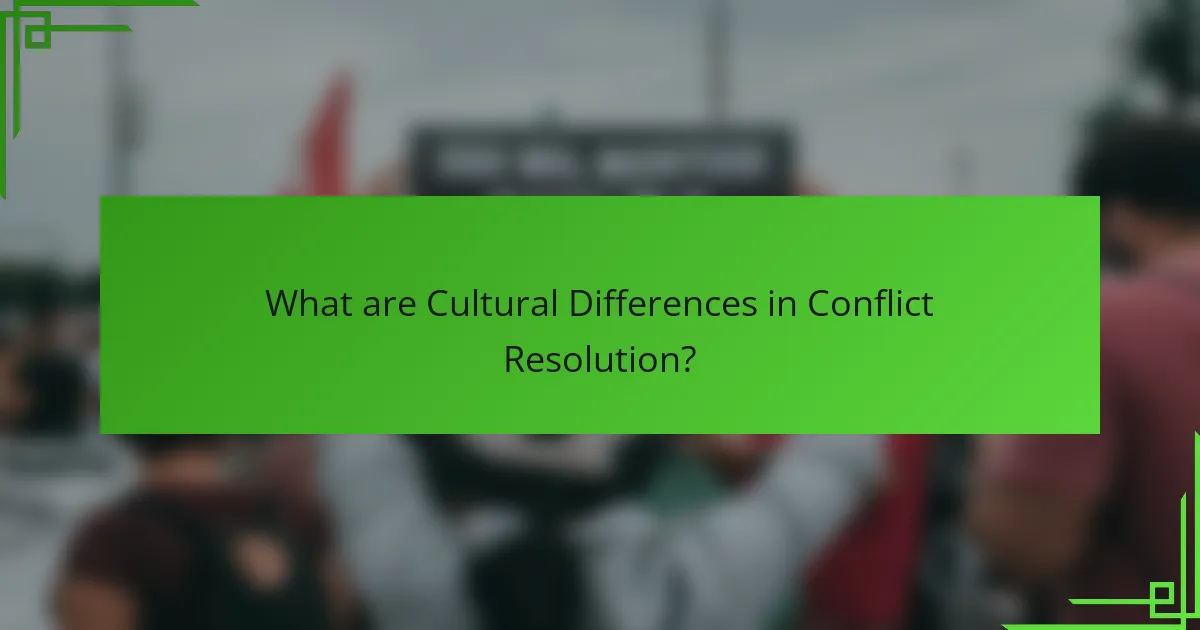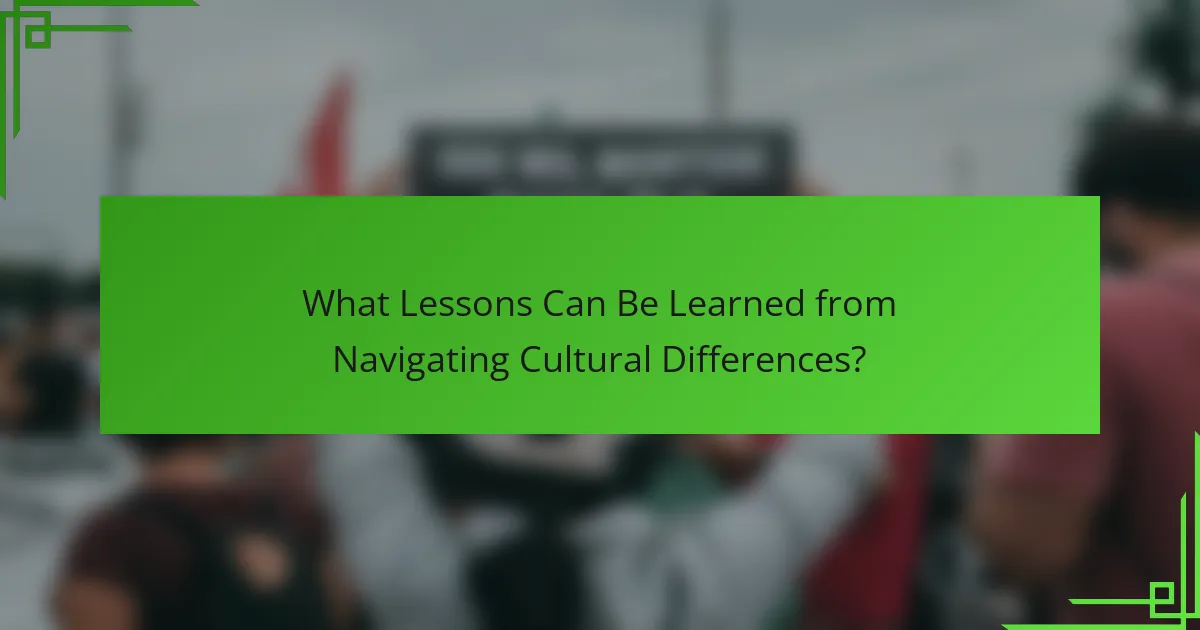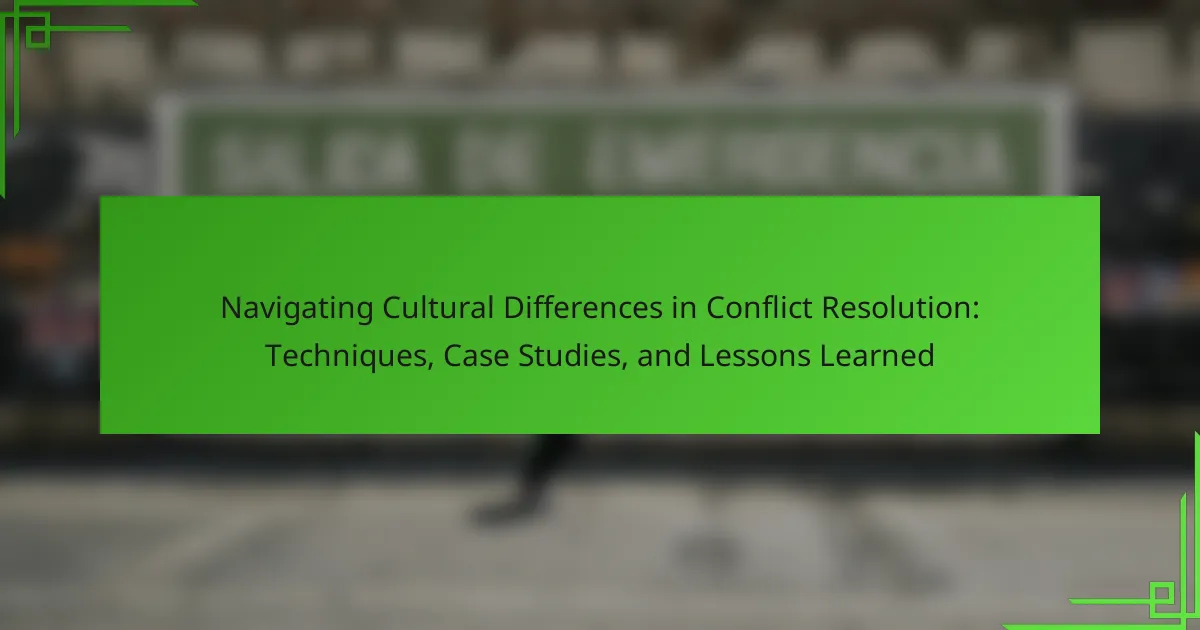Cultural differences in conflict resolution encompass the diverse methods individuals from various cultural backgrounds employ to handle disputes, shaped by their values, communication styles, and social norms. Collectivist cultures often prioritize group harmony, while individualistic cultures emphasize direct communication and personal accountability. Effective conflict resolution techniques include active listening, cultural awareness training, and empathy building, which enhance understanding and collaboration among parties. Case studies such as the Camp David Accords and the Truth and Reconciliation Commission in South Africa illustrate the importance of dialogue and cultural context in resolving conflicts. Understanding these cultural dimensions can lead to improved negotiation outcomes and foster respect in diverse environments.

What are Cultural Differences in Conflict Resolution?
Cultural differences in conflict resolution refer to the varying approaches individuals from different cultural backgrounds take to address disputes. These approaches can be influenced by values, communication styles, and social norms. For example, collectivist cultures may prioritize group harmony over individual expression. In contrast, individualistic cultures often emphasize direct communication and personal responsibility. Research indicates that understanding these differences can lead to more effective conflict resolution. A study by Thomas and Kilmann (1974) highlights five conflict-handling modes, which vary in effectiveness across cultures. Recognizing cultural contexts can enhance negotiation outcomes and foster mutual respect.
How do cultural differences influence conflict resolution approaches?
Cultural differences significantly influence conflict resolution approaches. Different cultures prioritize varying values, such as individualism versus collectivism. For example, Western cultures often emphasize direct communication and assertiveness. In contrast, many Eastern cultures value harmony and indirect communication.
These differences affect how conflicts are perceived and addressed. In collectivist societies, preserving relationships is crucial during conflict resolution. Individuals may avoid confrontation to maintain group cohesion. Conversely, in individualistic cultures, open debate is often seen as a means to reach a resolution.
Research indicates that cultural context shapes negotiation styles. A study by Gelfand et al. (2001) found that culture impacts conflict management strategies. Cultures with high power distance may prefer hierarchical solutions. Those with low power distance often seek egalitarian approaches.
Understanding these cultural nuances is vital for effective conflict resolution. Tailoring strategies to fit cultural contexts can lead to more successful outcomes.
What are the key attributes of cultural perspectives in conflict resolution?
Key attributes of cultural perspectives in conflict resolution include communication styles, values, and beliefs. Communication styles vary significantly across cultures. For instance, some cultures prefer direct communication, while others favor indirect approaches. Values influence how individuals prioritize relationships versus tasks. In collectivist cultures, group harmony is often prioritized. Beliefs shape perceptions of conflict and acceptable resolution methods. For example, some cultures may view conflict as a natural part of relationships, while others see it as negative. These attributes affect negotiation strategies and outcomes. Understanding these differences is crucial for effective conflict resolution. Research shows that culturally aware mediators achieve better results in diverse settings.
How do communication styles vary across cultures in conflict situations?
Communication styles vary significantly across cultures in conflict situations. Individualistic cultures, such as the United States, emphasize direct communication. In these contexts, individuals often articulate their thoughts and feelings openly. Collectivist cultures, like Japan, prioritize harmony and indirect communication. Here, individuals may avoid confrontation to maintain group cohesion.
High-context cultures rely on non-verbal cues and shared understanding. In these cultures, the context of the message is as important as the words used. Low-context cultures focus on explicit verbal communication. They prioritize clarity and straightforwardness in expressing disagreement.
Research by Gudykunst and Kim highlights these differences in communication styles. Their work emphasizes that misunderstandings can arise when individuals from different cultural backgrounds interact. For example, a direct approach may be perceived as rude in a collectivist culture. Conversely, indirect communication may be seen as evasive in an individualistic context.
Understanding these variations is crucial for effective conflict resolution. Recognizing and adapting to different communication styles can lead to more constructive outcomes in multicultural environments.
Why is understanding cultural differences crucial in conflict resolution?
Understanding cultural differences is crucial in conflict resolution because it influences perceptions and behaviors in interpersonal interactions. Cultural backgrounds shape communication styles, values, and conflict approaches. For instance, individualistic cultures may prioritize direct communication, while collectivist cultures value harmony and indirect communication. Misinterpretations can arise when these styles clash, leading to unresolved conflicts. Research shows that culturally informed conflict resolution strategies enhance collaboration and reduce misunderstandings. A study by Thomas and Kilmann (1974) highlights that recognizing cultural nuances can improve negotiation outcomes. Thus, understanding cultural differences fosters effective dialogue and promotes mutually acceptable solutions in conflict situations.
What impact do cultural misunderstandings have on conflict outcomes?
Cultural misunderstandings significantly impact conflict outcomes. They can escalate tensions and lead to miscommunication. Different cultural norms shape perceptions and responses in conflicts. For example, direct communication may be valued in one culture, while indirect approaches are preferred in another. This divergence can result in parties misinterpreting intentions and actions. Research indicates that misunderstandings can prolong disputes and hinder resolution efforts. A study by Thomas and Schmidt (2008) highlights that cultural differences often complicate negotiation processes. Effective conflict resolution requires awareness and sensitivity to these cultural dynamics.
How can cultural awareness improve conflict resolution effectiveness?
Cultural awareness can significantly enhance conflict resolution effectiveness. It enables individuals to understand diverse perspectives and communication styles. Recognizing cultural differences helps prevent misunderstandings. This understanding fosters empathy among conflicting parties. Empathy can lead to collaborative problem-solving approaches. Research shows that culturally aware mediators achieve higher satisfaction rates in resolutions. For example, a study by the Program on Negotiation at Harvard Law School found that culturally informed negotiation strategies improve outcomes. Thus, cultural awareness is essential for effective conflict resolution.

What Techniques are Effective for Navigating Cultural Differences?
Effective techniques for navigating cultural differences include active listening, cultural awareness training, and empathy building. Active listening fosters understanding by ensuring all parties feel heard. Cultural awareness training educates individuals about diverse backgrounds and practices. This knowledge helps prevent misunderstandings. Empathy building encourages seeing situations from others’ perspectives. These techniques promote respect and collaboration. Research indicates that organizations utilizing these methods experience improved communication and reduced conflicts. For instance, a study by the Center for Creative Leadership found that culturally competent leaders enhance team performance.
What are the most common techniques used in cross-cultural conflict resolution?
The most common techniques used in cross-cultural conflict resolution include negotiation, mediation, and cultural sensitivity training. Negotiation involves direct discussion between parties to reach a mutually acceptable solution. Mediation introduces a neutral third party to facilitate dialogue and understanding. Cultural sensitivity training educates individuals about different cultural norms and values, promoting empathy. These techniques are supported by research indicating that understanding cultural differences can reduce misunderstandings. Studies show that effective negotiation often leads to better outcomes in diverse environments. Mediation has been successful in resolving conflicts in multicultural settings, highlighting its effectiveness.
How does active listening play a role in resolving conflicts across cultures?
Active listening is crucial in resolving conflicts across cultures. It involves fully concentrating, understanding, responding, and remembering what is being said. This technique helps bridge communication gaps that often arise from cultural differences. Active listening fosters empathy and respect, allowing individuals to appreciate diverse perspectives. According to a study by K. A. Thomas and M. A. Schmidt, effective listening reduces misunderstandings and promotes collaboration in multicultural settings. Additionally, active listening encourages open dialogue, which is essential for conflict resolution. By validating each party’s feelings and viewpoints, active listening can lead to mutually beneficial solutions.
What role does empathy have in understanding cultural perspectives?
Empathy plays a crucial role in understanding cultural perspectives. It allows individuals to connect with others’ feelings and experiences. This connection fosters open communication and reduces misunderstandings. Empathy encourages individuals to view situations from different cultural viewpoints. Research shows that empathetic engagement can lead to more effective conflict resolution. A study published in the Journal of Cross-Cultural Psychology highlights that empathy enhances intercultural interactions. This improvement occurs because empathy promotes respect and validation of diverse cultural norms. Thus, empathy is essential for navigating cultural differences and resolving conflicts effectively.
How can negotiation strategies be adapted for cultural sensitivity?
Negotiation strategies can be adapted for cultural sensitivity by understanding and respecting diverse cultural norms. First, research the cultural background of the negotiating parties. This helps identify key values and communication styles. Second, adjust communication methods to align with cultural preferences. For example, some cultures value direct communication, while others prefer indirect approaches. Third, be aware of non-verbal cues, as gestures and body language can have different meanings across cultures. Additionally, practice active listening to demonstrate respect and understanding. Finally, be flexible in negotiation tactics, as cultural contexts may require alternative approaches to reach an agreement. These adaptations enhance mutual respect and improve negotiation outcomes.
What specific negotiation techniques are effective in diverse cultural contexts?
Effective negotiation techniques in diverse cultural contexts include active listening, building relationships, and understanding cultural norms. Active listening fosters trust and shows respect for differing viewpoints. Building relationships is essential in cultures that prioritize long-term partnerships over quick deals. Understanding cultural norms helps negotiators to navigate expectations and communication styles. For example, in collectivist cultures, consensus is often valued, while individualist cultures may prioritize personal achievement. Research shows that adapting to these cultural differences can lead to more successful outcomes in negotiations.
How can cultural norms shape negotiation outcomes?
Cultural norms significantly shape negotiation outcomes by influencing communication styles, decision-making processes, and relationship-building approaches. For instance, collectivist cultures prioritize group harmony and consensus, leading to more collaborative negotiation tactics. In contrast, individualistic cultures may focus on personal achievement and assertiveness, resulting in more competitive negotiation strategies.
Research shows that negotiators from different cultural backgrounds often interpret gestures, tone, and context differently, which can lead to misunderstandings. A study by Gelfand et al. (2013) highlights that cultural context affects how parties perceive fairness and trustworthiness during negotiations. Additionally, cultural norms dictate acceptable negotiation behaviors, such as the use of silence or directness, which can impact the overall effectiveness of the negotiation process.
Understanding these cultural influences allows negotiators to adapt their strategies, fostering better communication and more successful outcomes.

What Case Studies Illustrate Successful Conflict Resolution Across Cultures?
Case studies that illustrate successful conflict resolution across cultures include the Camp David Accords and the Truth and Reconciliation Commission in South Africa. The Camp David Accords, facilitated by U.S. President Jimmy Carter in 1978, resolved long-standing tensions between Egypt and Israel. This agreement led to peace between the two nations, showcasing the effectiveness of mediation and cultural understanding.
The Truth and Reconciliation Commission in South Africa aimed to address the injustices of apartheid. It allowed victims and perpetrators to share their experiences, fostering healing and dialogue. This approach emphasized restorative justice, illustrating how cultural context can shape conflict resolution strategies.
Both cases demonstrate that successful conflict resolution often involves dialogue, empathy, and recognition of cultural differences. These examples provide valuable lessons for navigating conflicts in diverse settings.
What are notable examples of cultural conflict resolution in practice?
Notable examples of cultural conflict resolution include the Truth and Reconciliation Commission in South Africa. This commission aimed to address the injustices of apartheid. It promoted dialogue between victims and perpetrators to foster healing. Another example is the peace process in Northern Ireland, which involved multi-party negotiations. The Good Friday Agreement established a framework for political cooperation among conflicting groups. Additionally, the United Nations often mediates cultural conflicts globally. Their peacekeeping missions help to facilitate dialogue and understanding. Each of these examples illustrates effective strategies for resolving deep-seated cultural conflicts through communication and mutual respect.
How did cultural understanding contribute to the success of these case studies?
Cultural understanding significantly contributed to the success of these case studies by facilitating effective communication. It enabled participants to navigate complex social dynamics and build trust. Understanding cultural norms helped identify potential conflicts before they escalated. This awareness allowed for tailored conflict resolution strategies that respected diverse perspectives. For instance, in one case study, recognizing the importance of collectivism led to collaborative problem-solving. Another case study demonstrated that acknowledging hierarchical structures improved stakeholder engagement. These factors collectively enhanced the likelihood of achieving mutually beneficial outcomes.
What lessons can be learned from these real-world examples?
Real-world examples in conflict resolution highlight the importance of cultural awareness. They demonstrate that understanding cultural differences can significantly impact negotiation outcomes. For instance, in the case of the 1995 peace negotiations in South Africa, recognizing diverse cultural backgrounds helped facilitate dialogue. This led to a more inclusive approach, ultimately resulting in a successful transition from apartheid. Additionally, the use of culturally sensitive communication strategies can reduce misunderstandings. Studies show that adapting conflict resolution techniques to fit cultural contexts improves relationships and fosters collaboration. These lessons underscore the need for cultural competence in resolving disputes effectively.
What challenges were faced in these case studies?
The challenges faced in these case studies included communication barriers and differing cultural norms. Communication barriers often led to misunderstandings and misinterpretations of intentions. Differing cultural norms created friction in conflict resolution approaches. In some cases, participants were unaware of the cultural significance behind certain behaviors. Additionally, power dynamics influenced the ability of individuals to express their concerns. Emotional responses varied significantly across cultures, complicating negotiations. Resistance to change was also a common challenge, as some participants preferred traditional methods. Lastly, lack of trust among parties hindered collaboration and effective resolution.
How were cultural barriers overcome in each case?
Cultural barriers were overcome in each case through effective communication and mutual respect. In one instance, facilitators employed active listening techniques to ensure all parties felt heard. This approach fostered an environment of trust and openness. Additionally, cultural sensitivity training was provided to participants, enhancing their understanding of differing perspectives. In another case, the use of neutral mediators helped bridge gaps between conflicting cultures. These mediators facilitated dialogue that focused on common goals rather than differences. Furthermore, establishing shared values was crucial in uniting diverse groups. Evidence from various case studies shows that these strategies significantly reduced misunderstandings and promoted collaboration.
What strategies were ineffective, and why?
Ineffective strategies in navigating cultural differences often include a lack of cultural awareness and reliance on one-size-fits-all approaches. These strategies fail because they do not consider the unique values and communication styles of different cultures. For instance, assuming that direct communication is valued universally can lead to misunderstandings. Additionally, neglecting to involve local stakeholders can result in a lack of trust and collaboration. Research indicates that cultural misinterpretations can escalate conflicts rather than resolve them. Such ineffective strategies highlight the importance of tailored approaches that respect and integrate cultural nuances.

What Lessons Can Be Learned from Navigating Cultural Differences?
Navigating cultural differences teaches valuable lessons about communication and empathy. Understanding diverse perspectives enhances conflict resolution skills. It fosters respect for varying beliefs and practices. This process encourages adaptability in problem-solving approaches. Studies show that culturally aware teams perform better in negotiations. For instance, research by Hofstede Insights highlights the impact of cultural dimensions on collaboration. Recognizing these differences leads to more effective teamwork and innovation. Ultimately, learning from cultural navigation improves interpersonal relationships and fosters inclusivity.
How can organizations implement lessons learned from cultural conflict resolution?
Organizations can implement lessons learned from cultural conflict resolution by integrating training programs focused on cultural awareness. These programs should emphasize understanding diverse perspectives and communication styles. Organizations can also establish clear policies that promote inclusivity and respect for all cultures. Regular workshops can provide ongoing education about cultural sensitivities and conflict management strategies.
Additionally, organizations should encourage open dialogue among employees to share experiences and insights. This fosters a collaborative environment where lessons learned are actively discussed. Leadership must model culturally competent behavior to reinforce these practices. Evidence shows that organizations with effective cultural conflict resolution strategies experience improved employee satisfaction and productivity, as noted in the study by Thomas and Ely (1996) in the Harvard Business Review.
What best practices should be adopted for future conflict resolution efforts?
Future conflict resolution efforts should adopt inclusive communication strategies. Engaging all parties fosters understanding and collaboration. Active listening is essential to ensure everyone feels heard. Cultural sensitivity training can enhance awareness of diverse perspectives. Mediation techniques should be employed to facilitate open dialogue. Establishing clear goals helps to focus discussions on resolution. Utilizing neutral facilitators can reduce bias and promote fairness. Documenting agreements ensures accountability and follow-through. These practices are supported by research indicating that inclusive approaches lead to more sustainable resolutions.
How can continuous learning improve cultural competence in conflict situations?
Continuous learning enhances cultural competence in conflict situations by fostering a deeper understanding of diverse perspectives. It allows individuals to acquire knowledge about different cultures, values, and communication styles. This knowledge equips individuals to navigate conflicts more effectively. Research shows that culturally competent individuals can reduce misunderstandings and build trust. For example, a study by the National Center for Cultural Competence highlights that ongoing education leads to better conflict resolution outcomes. Continuous learning also encourages empathy, which is crucial in resolving cultural conflicts. By engaging in regular training and reflection, individuals can adapt their approaches to diverse contexts. This adaptability is essential in today’s multicultural environments.
What practical tips can enhance cultural sensitivity in conflict resolution?
To enhance cultural sensitivity in conflict resolution, individuals should actively listen to all parties involved. This involves giving full attention and understanding their perspectives. Additionally, acknowledging cultural differences can prevent misunderstandings. Recognizing that cultural backgrounds influence communication styles is essential. Practicing empathy allows one to connect with others’ feelings and experiences. Using inclusive language helps create a respectful dialogue. Being aware of non-verbal cues is also critical, as they vary across cultures. Finally, seeking common ground fosters collaboration and reduces tension. These strategies collectively improve the effectiveness of conflict resolution in diverse settings.
How can individuals prepare for culturally diverse conflict scenarios?
Individuals can prepare for culturally diverse conflict scenarios by enhancing their cultural competence. Cultural competence involves understanding and respecting different cultural backgrounds. This preparation includes actively researching diverse cultures. Individuals should learn about values, communication styles, and conflict resolution preferences of various groups.
Training programs on cultural awareness can provide essential skills. These programs often include role-playing and simulations. Engaging in discussions with diverse groups can also foster understanding. Practicing active listening helps individuals grasp different perspectives.
Research indicates that culturally competent individuals are more effective in conflict resolution. A study by the American Psychological Association highlights that cultural awareness reduces misunderstandings. This preparation ultimately leads to more constructive outcomes in diverse settings.
What resources are available to improve cultural awareness and conflict resolution skills?
Educational programs and workshops are available to improve cultural awareness and conflict resolution skills. These resources often include training sessions focused on intercultural communication. Online courses from platforms like Coursera and edX provide structured learning. Books such as “Cultural Intelligence” by David Livermore offer in-depth insights. Additionally, organizations like the International Institute for Conflict Prevention and Resolution provide valuable materials. Role-playing exercises can also enhance practical skills in real-world scenarios. Research shows that these resources significantly increase understanding and effectiveness in diverse environments.
Navigating Cultural Differences in Conflict Resolution is a comprehensive examination of how cultural backgrounds influence conflict resolution approaches. The article explores key attributes such as communication styles, values, and beliefs that shape perceptions and responses in conflicts. It highlights effective techniques for managing cultural differences, including active listening and cultural sensitivity training, and presents notable case studies that illustrate successful conflict resolution. Additionally, the article discusses the challenges faced in cross-cultural negotiations and offers practical tips for enhancing cultural awareness to improve resolution outcomes.
